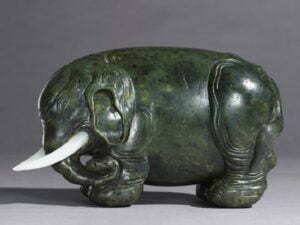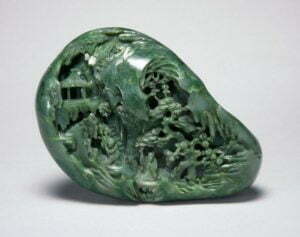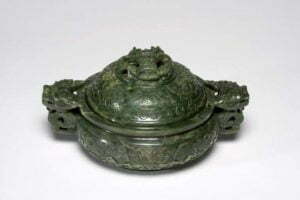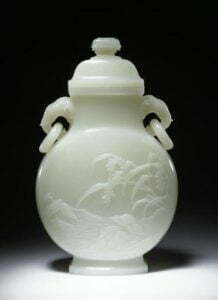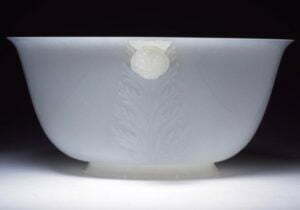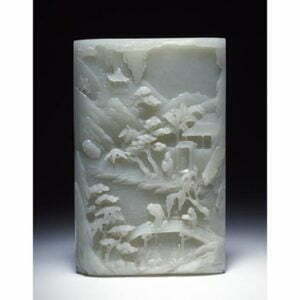Jade
Jade or ‘Yu’ – (‘Heavenly Stone’) as it known in China, has been highly sought after and appreciated since the Neolithic era. It is an incredibly hard material and therefore cannot be carved in the conventional manner as with other stone. It has to be worked by an abrasive technique on a lathe. The best quality pieces were made for the imperial court and could take many months to fashion into finished objects and were thus highly valued.
The two types of jade that have been worked are nephrite (a silicate of calcium and magnesium) and jadeite (a silicate of sodium and aluminium). Nephrite is the more common type found and is known as ‘mutton fat’ in China and is more opaque than jadeite. Nephrite can be found in a number of colours, but white is currently the most fashionable and sought after amongst the Chinese. Yellow jade, which often has russet inclusions, is also highly sought after and is valuable due to its rarity. Other colours include celadon, brown and grey.
Smaller, handling jades were generally worked from river pebbles where the shape and integrity of the original stone was maintained. These often took the form of animals, such as lions, horses (Fig J1), elephants (Fig J2) or boulders of sages in rocky landscapes (Fig J3).
Photograph © Fitzwilliam Museum.
Photograph © Ashmolean Museum.
Photograph © Fitzwilliam Museum.
Jade was also mined and larger pieces became more plentiful in the Qianlong period after the annexation of the area of Khotan in present day Xinjian in north west China in 1759. Utilitarian objects such as brush pots (Fig J4), incense burners (Fig J5), vases and covers (Fig J6) ewers, bowls (Fig J7), mounted relief plaques (Fig J8) and ruyi sceptres where manufactured in large numbers for the use of the court and the literati scholar class.
Photograph © Ashmolean Museum.
Photograph © Fitzwilliam Museum.
Photograph © Victoria & Albert Museum.
Jadeite is most commonly found in a bright translucent green colour and at its best, is highly sought after and used in jewellery. It is quite rare to find jadeite pieces dating from the 18th century and most pieces tend to date from the 19th and 20th century. Decorative and utilitarian objects have also been fashioned in tones of lilac, white and pale green (Fig J9).
Photograph © Victoria & Albert Museum.
Photograph © Victoria & Albert Museum.
Photograph © Fitzwilliam Museum.

